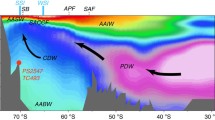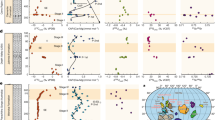Abstract
MEASUREMENTS of the cadmium content of marine CaCO3 deposits, such as aragonitic corals1 and foraminiferal shells2,3, have been used to trace past ocean circulation2 and as an indicator of labile nutrient concentrations4. In particular, studies of foraminiferal cadmium have provided insight into the oceanic processes controlling atmospheric CO2 concentration in glacial times5,6. The use of Cd/Ca ratios in CaCO3 as a labile nutrient indicator is made possible by a relationship between seawater cadmium and phosphate content that is remarkably uniform throughout the present ocean (Fig.l). In deep waters of the open ocean, [Cd] at a given value of [PO3−4] is consistent within about ±7%; However, there is a unusual kink in the relationship at [PO3−4]≈ 1.3 μmol kg−1 whose cause is not known but which has been suggested2 to result from a slightly deeper regeneration cycle for Cd relative to PO3−4. Points to the right of the kink correspond mainly to intermediate and deep waters of the North Pacific, whereas low PO3−4 concentrations to the left of the kink represent mainly Atlantic and upper-ocean waters4. Waters of the Southern Ocean have a strong influence on the composition of the global ocean but few Cd–PO3−4 measurements are available for this region. Here we present recent data for Cd and PO3−4 in Southern Ocean waters, which suggest that the kink is created by the input of Cd-depleted Subantarctic waters into the intermediate waters of the global ocean.
Similar content being viewed by others
References
Shen, G. T., Boyle, E. A. & Lea, D. W. Nature 328, 794–795 (1987).
Boyle, E. A. Paleoceanography 3, 471–489 (1988).
Boyle, E. A. J. geophys. Res. 93, 15701–15715 (1988).
Boyle, E. A. & Keigwin, L. D. Nature 330, 35–40 (1987).
Boyle, E. A. Geochim. cosmochim. Acta 50, 265–576 (1986).
Broecker, W. S. & Peng, T.-H. Global biogeochem. Cycles 3, 215–239 (1989).
Tchernia, P. Descriptive Regional Oceanography, 43–45 (Pergamon, Oxford, 1980).
Kuehnen, E. C., Alvarez, R., Paulson, P. J. & Murphy, T. J. Analyt. Chem. 44, 2050–2056 (1972).
Danielsson, L. Mar. Chem. 8, 199–215 (1980).
McLellan, H. J. Elements of Physical Oceanography, 49 (Pergamon, 1965).
Martin, J. H., Gordon, R. M. & Fitzwater, S. E. Nature 345, 156–158 (1990).
Walsh, R. S. & Hunter, K. A. Limnol. Oceanogr. (in the press).
Broecker, W. S. & Peng, T.-H. Tracers in the Sea, 8–14 (Eldigio, New York, 1982).
Tchernia, P. Descriptive Regional Oceanography, 161 (Pergamon, Oxford, 1980).
Author information
Authors and Affiliations
Rights and permissions
About this article
Cite this article
Frew, R., Hunter, K. Influence of Southern Ocean waters on the cadmium–phosphate properties of the global ocean. Nature 360, 144–146 (1992). https://doi.org/10.1038/360144a0
Received:
Accepted:
Issue Date:
DOI: https://doi.org/10.1038/360144a0
- Springer Nature Limited





